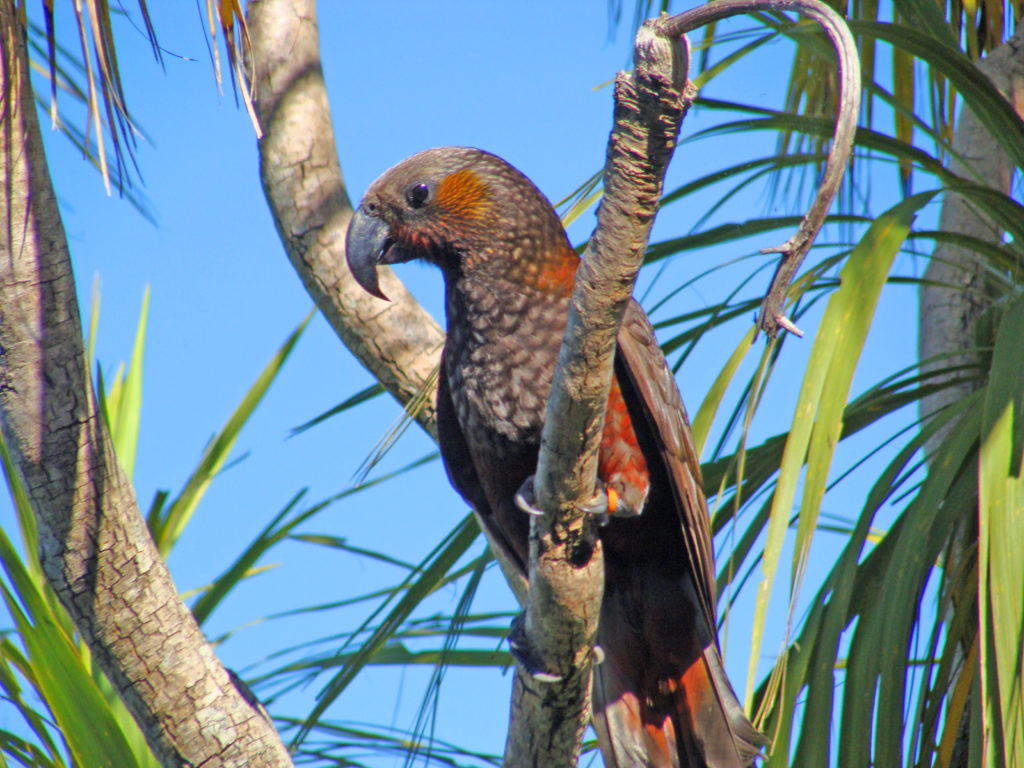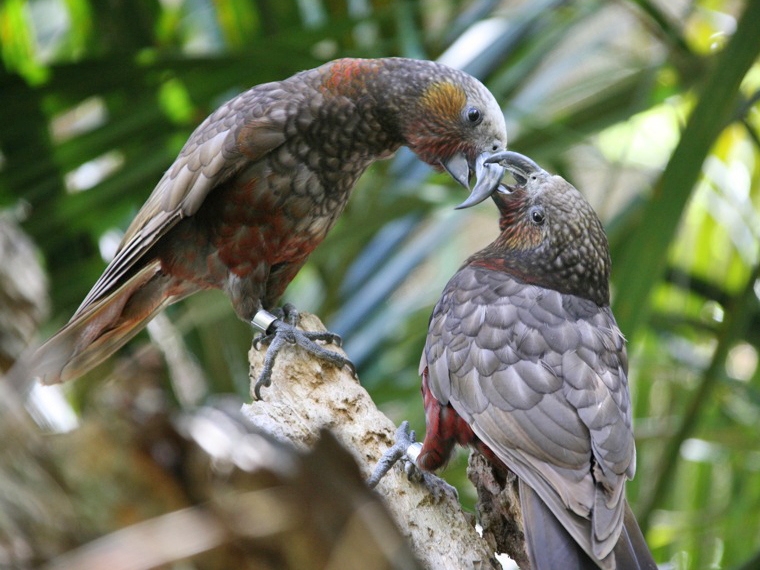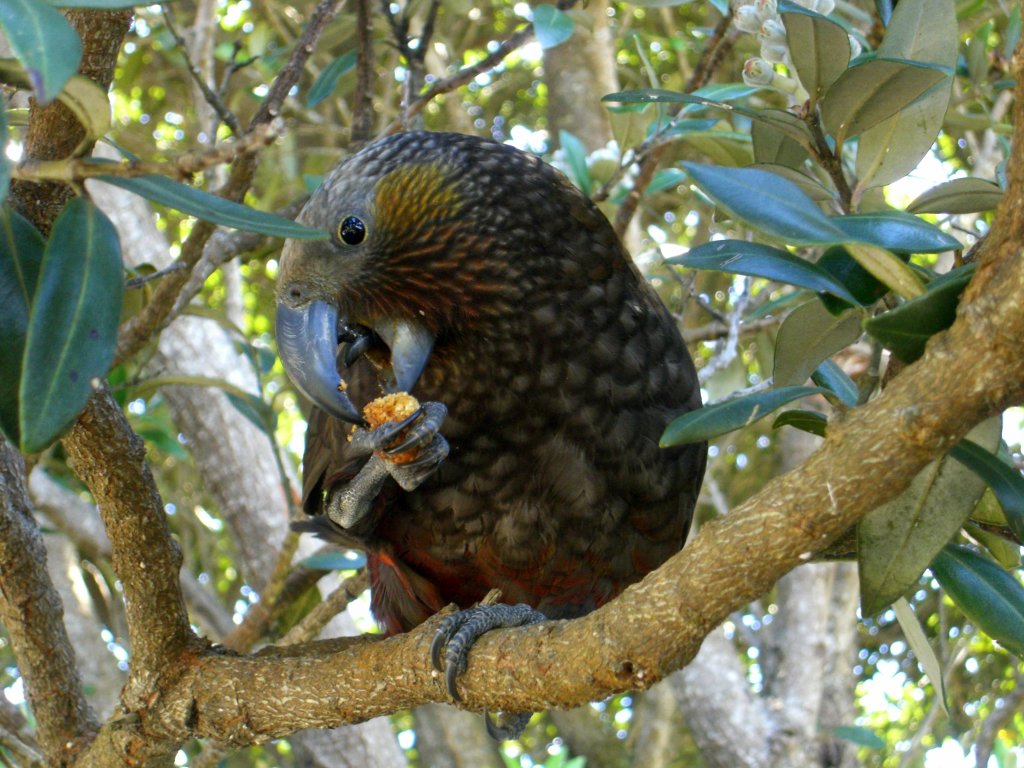As kaka become a more familiar part of everyday suburban lives in some parts of New Zealand, the city-living parrots are also attracting the attention of researchers interested in the parrot/urban mix. How well are urban kaka learning to adapt to city life and what might be some city threats that they face?
Researchers from both Massey University and Victoria University of Wellington have been investigating Wellington’s kaka in two separate studies. One project looked at how kaka learn and whether they continue to learn from new experiences throughout their lives and the second looked at lead levels and urban sources of lead. Both projects were based at Wellington’s Zealandia.

Victoria University of Wellington biologists Julia Loepelt, Rachael C. Shaw and Kevin C. Burns looked at cognitive development in wild kaka, testing their ability to complete three problem-solving tasks, in a paper published in Proceedings of the Royal Society.
“We tested 104 kaka (Nestor meridionalis), ranging in age from four months to 13 years. Twenty-four individuals participated in all three of our problem-solving tasks, two of which involved a familiar feeder and one an entirely novel apparatus.”

So does age bring wisdom in parrot terms or does juvenile curiosity and innovation win out?
“A number of studies have found that innovation rates are correlated with personality traits, such as neophilia and exploration. Juvenile birds are frequently more neophilic and explorative, yet few studies have found evidence of age-related differences in innovative problem-solving success.”
“Juveniles were the most efficient problem-solvers in all three tasks. By contrast, the adults’ success was context dependent and limited to the novel apparatus, which did not require modification of a pre-learned behavioural response. This suggests greater behavioural flexibility in the juvenile birds, who also showed higher persistence and exploratory diversity than adults.”
The research paper is published in Proceedings of the Royal Society and is freely available online:
Exploring the wider world may also bring dangers for urban kaka as the second research project, completed as part of a Masters degree, reveals.
Aditi Sriram studied lead exposure in Wellington’s urban population of free-ranging kaka as part of studies for a Master of Veterinary Science in Wildlife Health degree at Massey University.
“Lead is a highly toxic, non-essential heavy metal recognised as a cause of morbidity and mortality in birds. Ecotoxicological investigations in wild birds have thus far prioritised waterfowl and raptor species and primarily addressed contamination in natural ecosystems. Urban areas are increasingly associated with high levels of heavy metal contamination, however the risk of lead exposure in urban wildlife is less well known. This study aimed to identify the significance of lead exposure in a well-established urban population of kaka (Nestor meridionalis septentrionalis).”
The project involved sampling blood lead levels in both adult and nestling kaka to see how common lead exposure was and to measure what the magnitude of lead levels were. The likely sources of lead exposure were also investigated using lead stable isotope analysis.

So are urban kaka in danger of accumulating toxic levels of lead and where might that lead be coming from?
“Lead exposure is prevalent in this kaka population, with 43.2% of adults and 36.7% of nestlings with detectable blood lead concentrations. Blood lead concentrations in nestlings ranged from <3.3 to 42.9ug/dL, with no detectable neurological or physiological deficits. The pattern of exposure in chicks is suggestive of parental feeding of lead, however detection of lead in some eggshells suggests that maternal transfer is another route of exposure in this species.”
Blood lead levels were even higher in adult birds.
“Blood lead concentrations in adult birds ranged between 3.4 to 50.7ug/dL. Although no acute clinical signs of toxicity were observed, lead exposure was associated with reduced body condition in adults. Behavioural changes were present in one individual with the highest recorded blood lead concentration.”
So where is the lead coming from?
“Lead isotope ratios in kaka blood samples overlap with isotope values of roof-collected rainwater, suggesting this to be an important source of exposure in this population. The prevalence of lead exposure observed in this study suggests that lead is a threat to kaka interacting with urban areas.”
The full thesis is freely available online through Massey University’s website.

